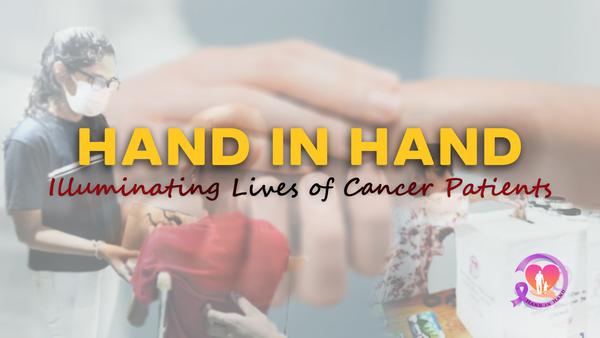Let's fight against Cancer: Types of Cancer - Skin cancer
According to the World Cancer Research Fund, Melanoma skin cancer is the 19th most common type of cancer among men and women (300,000 cases) in the world in 2018. Also, Non-melanoma skin cancer is the 5th most common cancer among men and women and more than 1 million patients were diagnosed in 2018. In 2018, Australia had the highest melanoma skin cancer rate around the world
Skin cancer is the most common cancer. These cancers can occur on the skin of the face, neck, lips, head, chest, limbs, and ears. Almost all skin cancers can be effectively treated if detected early. There are many types of skin cancer, and each of them can look different on the skin. This is why it is important to meet a doctor if you have bumps, lumps, spots, sores or other signs on your skin that are new or changing or worrying for some other reason.
What is skin cancer?
Most skin cancers start in the cells that make up the outer layer of skin, called the epidermis. There are 3 main types of cells in this layer: Squamous cells, Basal cells and Melanocytes. The epidermis is separated from the deeper layers of skin by the basement. When a skin cancer spreads, it usually develops through this barrier and into the deeper layers.
Common types of skin cancer:
Basal cell carcinoma
Basal cell carcinoma begins in the basal cell layer, the lower part of the epidermis. Basal cell cancer is the most common type of skin cancer. 8 out of 10 skin cancers are caused by basal cell carcinomas. These cancers usually develop in areas exposed to the sun, especially on the face, head and neck. They tends to grow slowly and in very rare instances they can be fatal.
If not completely removed, the basal cells can return to the same place on the skin. People with basal cell carcinoma are more likely to develop it elsewhere.
Squamous cell carcinoma
Squamous cell carcinomas start in the flat cells in the upper part of the epidermis. About 2 in 10 skin cancers are squamous cell carcinomas. These cancers are most commonly found on the face, ears, neck, lips and behind the sun exposed areas of the body. This cancer can also develop in scars or chronic skin sores elsewhere. Sometimes It begins in actinic keratosis. Less often, they form in the skin of the genital area.
Squamous cell cancers can be treated and removed completely, although they can grow into deeper layers of skin and spread to other parts of the body.
Melanoma
These cancers develop from melanocytes, pigment-producing cells found in the epidermis. Melanomas are less common than basal and squamous cell cancers. But melanoma is more dangerous because if left untreated, they are more likely to grow and spread to other parts of the body.
Melanoma can grow anywhere on the skin, but it is more likely to start on the trunk in men (chest and back) and on the legs in women. The neck and face are other common sites. Having darker pigmented skin reduces the risk of melanoma in these more common places, but anyone can get melanoma on the hands, feet or under the nails.
Merkel cell carcinoma, Kaposi sarcoma, Cutaneous (skin) lymphoma, Skin adnexal tumors (tumors that start in hair follicles or skin glands) and various types of sarcomas are some of the rare skin cancer types. There are many other types of skin cancer. Most often, melanoma is classified as skin cancer and non-melanoma skin cancer. It is often treated in different ways.
Symptoms of skin cancer:
Basal cell carcinomas
· Flat, firm, pale or yellow areas, similar to a scar
· Raised reddish patches that might be itchy
· Small, pink or red, translucent, shiny, pearly bumps, which might have blue, brown, or black areas
· That might contain abnormal blood vessels spreading out like the spokes of a wheel
Squamous cell carcinomas
· A firm, red patches, which might bleed
· A flat lesion with a scaly, crusted surface
· Wart-like growths
Melanoma
· A new spot on the skin or a spot that is changing in size, shape, or color
· Redness or a new swelling beyond the border of the mole and Change in the surface of a mole (Itching, bleeding, the appearance of a lump or bump)
· Change in sensation, such as itchiness, tenderness, or pain
Causes of skin cancer
· Exposure to Ultraviolet rays causes 95% of melanoma, the deadliest form of skin cancer
· Inherited gene mutations
· Due to unhygienic health practices
· Due to exposure to harmful radiation and the deposition of those chemicals on the skin
Risk factors
· Ultraviolet (UV) light exposure
· Having light-colored skin
· Being older
· Being male (but before age 50, the risk is higher for women)
· Previous skin cancer
· Long-term or severe skin inflammation or injury
· Human papillomavirus (HPV) infection
· Smoking
Skin cancers can be removed. In more advanced skin cancers, some surrounding tissue can be removed to make sure all of the cancer cells have been removed. The most common treatment for skin cancer is cancer removal surgery. Common skin cancers can be treated with ointments or Radiotherapy. Skin cancer can also be removed with cryotherapy (using liquid nitrogen to rapidly freeze the cancer off), curettage (scraping) or burning.
Skin cancer awareness ribbon color: Black
Skin cancer awareness month: May
ලෝක පිළිකා පර්යේෂණ අරමුදලට අනුව, මෙලනෝමා සමේ පිළිකා යනු 2018 දී ලොව පුරුෂයින් හා කාන්තාවන් අතර 19 වන වඩාත් සුලභ පිළිකා වර්ගයයි (මිලියන 300,000 ක්). එසේම, මෙලනෝමා නොවන සමේ පිළිකා පිරිමින් සහ කාන්තාවන් අතර 5 වන වඩාත් සුලභ පිළිකාව වන අතර රෝගීන් මිලියනයකට වඩා 2018 දී හඳුනාගෙන ඇත. 2018 දී ඕස්ට්රේලියාවේ වැඩිම මෙලනෝමා සමේ පිළිකා අනුපාතය ඇත.
සමේ පිළිකා වඩාත් සුලභ පිළිකාවකි. මෙම පිළිකා මුහුණ, ගෙල, තොල්, හිස, පපුව, අත් පාද, කන් යන ඕනෑම සම ආශ්රිත ප්රදේශයක ඇති විය හැක.කල්තියා හඳුනාගත හොත් සමේ පිළිකා සියල්ලම පාහේ ඵලදායී ලෙස ප්රතිකාර කළ හැකිය. සමේ පිළිකා වර්ග බොහොමයක් ඇති අතර, ඒ සෑම එකක්ම සම මත වෙනස් ලෙස පෙනිය හැකිය. ඔබේ සමේ ගැටිති, ලප, තුවාල හෝ වෙනත් සළකුණු තිබේ නම් වෛද්යවරයකු හමුවීම වැදගත් වන්නේ මේ නිසා ය.
සමේ පිළිකා යනු කුමක්ද ?
බොහෝ සමේ පිළිකා ආරම්භ වන්නේ සමේ පිටත තට්ටුව සෑදෙන සෛල වලිනි. මෙම ස්තරයේ ප්රධාන සෛල වර්ග 3 ක් ඇත: චතුරස්රාකාර සෛල, බාසල් සෛල සහ මෙලනොසයිට්. එපීඩර්මිස් සමේ ගැඹුරු ස්ථර වලින් පහළම මාලය මගින් වෙන් කරනු ලැබේ. සමේ පිළිකාවක් වඩාත් දියුණු වූ විට එය සාමාන්යයෙන් මෙම බාධකය හරහා ගැඹුරු ස්ථර දක්වා වර්ධනය වේ.
බහුලව දක්නට ලැබෙන සමේ පිළිකා වර්ග:
බාසල් සෛල පිළිකා
බාසල් සෛල පිළිකා ආරම්භ වන්නේ එපීඩර්මිස් වල පහළ කොටස වන බාසල් සෛල ස්ථරයේ ය. බාසල් සෛල පිළිකා යනු සමේ පිළිකා වල වඩාත් සුලභ වර්ගයකි. සමේ පිළිකා 10 න් 8 ක්ම බාසල් සෛල පිළිකා වේ. මෙම පිළිකා සාමාන්යයෙන් හිරු එළියට නිරාවරණය වන ප්රදේශවල, විශේෂයෙන් මුහුණ, හිස සහ බෙල්ල මත වර්ධනය වේ. ඒවා සෙමින් වර්ධනය වීමට නැඹුරු වන අතර ඒවා මාරාන්තික විමේ හැකියාව ඉතා දුර්ලභය. සම්පූර්ණයෙන්ම ඉවත් නොකළ හොත්, බාසල් සෛල සම මත එකම ස්ථානයට නැවත පැමිණිය හැකිය. බාසල් සෛල පිළිකා ඇති පුද්ගලයින් අතර එය වෙනත් තැනක වර්ධනය වීමට වැඩි අවදානමක් ඇත.
චතුරස්රාකාර සෛල පිළිකා
මෙම පිළිකා ආරම්භ වන්නේ එපීඩර්මිස් හි ඉහළ කොටසේ පැතලි සෛල වලිනි. සමේ පිළිකා 10 න් 2 ක් පමණ චතුරස්රාකාර සෛල පිළිකා වේ. මෙම පිළිකා බහුලව දක්නට ලැබෙන්නේ මුහුණ, කන්, බෙල්ල, තොල් සහ ශරීරයේ හිරු එළියට නිරාවරණය වන ප්රදේශවල ය. මෙම පිළිකාව නිසා වෙනත් තැන්වල කැළැල් හෝ නිදන්ගත සමේ තුවාල ඇතිවිය හැක. එය සමහර විට ඇක්ටිනික් කෙරටෝසිස් වලින් ආරම්භ වේ. බොහෝ විට ඒවා ලිංගික අවයවයේ සමෙහි සාදයි.
චතුරස්රාකාර සෛල පිළිකා වලට ප්රතිකාර කර සම්පූර්ණයෙන්ම ඉවත් කළ හැකිය, නමුත් ඒවා සමේ ගැඹුරු ස්ථර දක්වා වර්ධනය වී ශරීරයේ අනෙකුත් කොටස් වලට පැතිර යා හැකිය.
මෙලනෝමා
මෙම පිළිකා වර්ධනය වන්නේ එපීඩර්මිස් වල දක්නට ලැබෙන වර්ණක සාදන සෛල වන මෙලනොසයිට් වලිනි. බාසල් සහ චතුරස්රාකාර සෛල පිළිකා තරම් මෙලනෝමා බහුල නොවේ. නමුත් මෙලනෝමා වඩාත් භයානක වන්නේ එයට ඉක්මනින් ප්රතිකාර නොකළහොත් ශරීරයේ අනෙකුත් කොටස් වලට පැතිරීමට ඇති ඉඩකඩ වැඩි නිසාය.
මෙලනෝමා සම මත ඕනෑම තැනක වර්ධනය විය හැකි නමුත් ඒවා පුරුෂයින්ගේ කඳ (පපුව සහ පිටුපසට) සහ කාන්තාවන්ගේ කකුල් මත ආරම්භ වීමට වැඩි ඉඩක් ඇත. බෙල්ල සහ මුහුණ වෙනත් පොදු අඩවි වේ. අඳුරු වර්ණක සහිත සමක් තිබීම මෙම මෙලනෝමා පිළිකා අවදානම අඩු කරයි, නමුත් ඕනෑම කෙනෙකුට අත් වල, පාදවල හෝ නියපොතු යට මෙලනෝමා ඇතිවිය හැක.
මර්කෙල් සෛල පිළිකා, කපෝසි සාර්කෝමා, කටේනියස් (සම) ලිම්ෆෝමා, සම ඇඩෙනෙක්සල් පිළිකා (කෙස්වල හෝ සමේ ග්රන්ථි වලින් ආරම්භ වන පිළිකා) සහ විවිධ වර්ගයේ සාර්කෝමා යනු දුර්ලභ සමේ පිළිකා වර්ග කිහිපයකි. සමේ පිළිකා සඳහා තවත් බොහෝ වර්ග තිබේ. බොහෝවිට, මෙලනෝමා සමේ පිළිකා සහ මෙලනෝමා නොවන සමේ පිළිකා ලෙස කාණ්ඩගත වේ. බොහෝ විට විවිධ ක්රම මගින් ප්රතිකාර කරනු ලැබේ.
සමේ පිළිකාවේ රෝග ලක්ෂණ
බාසල් සෛල පිළිකා
· කැළලකට සමාන පැතලි, ස්ථිර, සුදුමැලි හෝ කහ ප්රදේශ
· කැසීම ඇති විය හැකි රතු පැහැයට හුරු පැච්
· කුඩා, රෝස හෝ රතු, පාරභාසක, දිලිසෙන, මුතු ගැටිති, ඒවා නිල්, දුඹුරු හෝ කළු ප්රදේශ තිබිය හැකිය
· රෝදයක කටුව මෙන් පැතිරෙන අසාමාන්ය රුධිර නාල එහි අඩංගු විය හැකිය
චතුරස්රාකාර සෛල පිළිකා
· තද රතු පැල්ලම් ඇති විය හැක
· කොරපොතු පෘෂ්ඨයක් සහිත පැතලි තුවාලයක්
· ඉන්නන් වැනි වර්ධනයන්
මෙලනෝමා
· සම මත නව පැල්ලමක් හෝ ප්රමාණය, හැඩය හෝ වර්ණය වෙනස් වන පැල්ලමක්
· මවුලයේ සීමාවෙන් ඔබ්බට රතු වීම හෝ නව ඉදිමීම සහ මවුලයක මතුපිට වෙනස් වීම (කැළැල්, ලේ ගැලීම, ගැටිත්තක් හෝ ගැටිත්තක පෙනුම)
· කැසීම, මුදු මොළොක් හෝ වේදනාව
සමේ පිළිකා ඇතිවීමට හේතු
· පාරජම්බුල කිරණවලට නිරාවරණය වීමෙන් සමේ පිළිකා ඇතිවීමේ මාරාන්තික ස්වරූපය වන මෙලනෝමා වලින් 95% ක්ම හේතු වේ.
· උරුම වූ ජාන විකෘති
· අපිරිසිදු සෞඛ්ය පුරුදු නිසා
· අහිතකර විකිරණ වලට නිරාවරණය වීම හා එම රසායන ද්රව්ය සම මත තැන්පත් වීම හේතුවෙන්
අවදානම් සාධක
· පාරජම්බුල (UV) ආලෝක නිරාවරණය
· ලා පැහැති සමක් තිබීම
· වයසින් මුහුකුරා යාම
· පිරිමි වීම (නමුත් වයස අවුරුදු 50 ට පෙර අවදානම කාන්තාවන්ට වැඩිය)
· පෙර සමේ පිළිකා
· දිගු කාලීන හෝ දරුණු සමේ දැවිල්ල හෝ තුවාල වීම
· මානව පැපිලෝමා වයිරස් (HPV) ආසාදනය
· දුම්පානය
සමේ පිළිකා සෑම විටම පාහේ ඉවත් කරනු ලැබේ. වඩාත් වර්ධනය වී ඇති සමේ පිළිකා වලදී, පිළිකා සෛල සියල්ලම පිටතට ගෙන ඇති බව තහවුරු කර ගැනීම සඳහා අවට ඇති සමහර පටක ඉවත් කළ හැකිය. සමේ පිළිකා සඳහා වඩාත් පොදු ප්රතිකාරය වන්නේ පිළිකාව ඉවත් කිරීමේ සැත්කම් ය. සාමාන්ය සමේ පිළිකා වලට විලවුන් හෝ විකිරණ චිකිත්සාව මගින් ප්රතිකාර කළ හැකිය. ක්රියෝතෙරපි (දියර නයිට්රජන් භාවිතයෙන් පිළිකාව වේගයෙන් කැටි කිරීම), සුව කිරීම (සීරීම) හෝ දැවීම මගින් සමේ පිළිකා ඉවත් කළ හැකිය.
සමේ පිළිකා පිළිබඳ දැනුවත් රිබන් වර්ණය: කළු
සමේ පිළිකා පිළිබඳ දැනුවත් කිරීමේ මාසය: මැයි
Check out our other blogs on cancer;
1) What is cancer: https://blog.rotaractmora.org/what-is-cancer/
2) What causes cancer: http://blog.rotaractmora.org/causes-of-cancer/
3) Childhood cancer: http://blog.rotaractmora.org/fight-against-cancer/
4) Leukemia: https://blog.rotaractmora.org/hih-cancer-leukemia/
5) Brain cancer: https://blog.rotaractmora.org/brain-cancer/
6) Lung cancer: https://blog.rotaractmora.org/lung-cancer/
7) Breast cancer: https://blog.rotaractmora.org/breast-cancer/
8) Skin cancer: http://blog.rotaractmora.org/skin-cancer/
9) Oral cancer: https://blog.rotaractmora.org/oral-cancer/
10) Thyroid cancer: https://blog.rotaractmora.org/thyroid-cancer-2/
11) Movie review- The fault in our stars: https://blog.rotaractmora.org/movie-review-the-fault-in-our-stars/
12) Cervical cancer: http://blog.rotaractmora.org/cervical-cancer/
13) Colorectal cancer: http://blog.rotaractmora.org/colorectal-cancer/
14) Movie review: My life without me: http://blog.rotaractmora.org/moviereviewmylifewithoutme/
15) Cancer health policy of WHO: http://blog.rotaractmora.org/health-policy-of-who/



